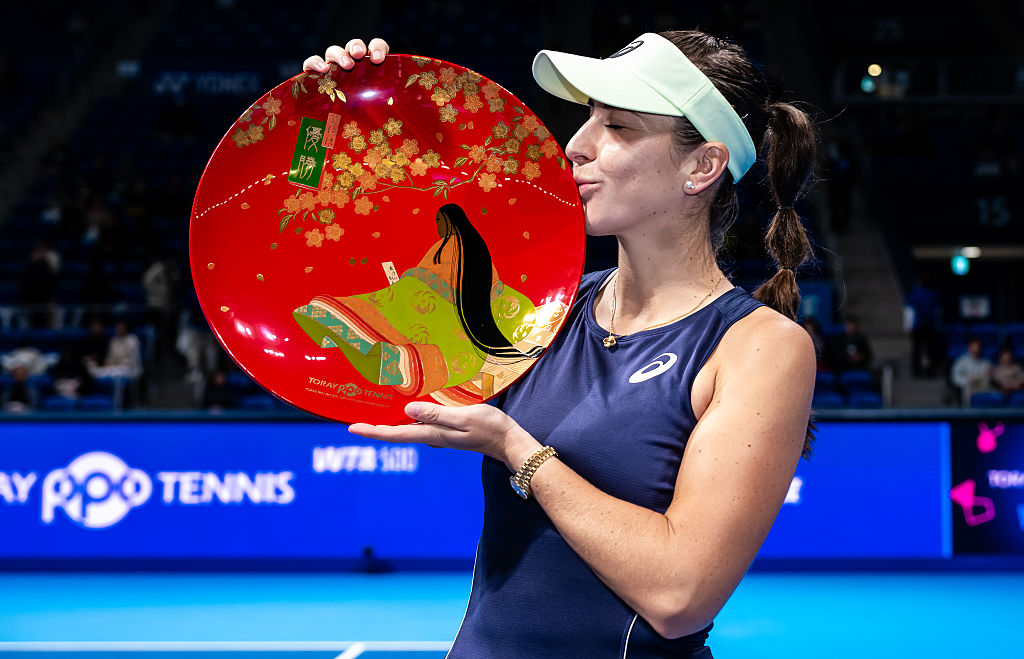Belinda Bencic entered Sunday’s Toray Pan Pacific Open final at a clear disadvantage.
Tokyo: Scores | Draw | Order of play
Her opponent, 20-year-old Linda Noskova, had spent just 35 minutes on court across the quarterfinal and semifinal rounds in Tokyo, advancing via a retirement and a walkover. Bencic, meanwhile, logged 5 hours and 23 minutes over the previous two days, battling through back-to-back three-set matches. Her quarterfinal win over Karolina Muchova required a comeback from a set down and saw her save a match point.
None of that mattered in the final. The 28-year-old Bencic defeated Noskova 6-2, 6-3 in 1 hour and 22 minutes to claim redemption for her loss in the final of the very same tournament 10 years ago.
A former Olympic gold medalist — also won in Tokyo — Bencic now climbs to No. 11 in the PIF WTA Rankings, putting her back on the cusp of the top 10.
“It was wonderful playing in front of you guys,” Bencic said after the match. “The last time I won here was the Tokyo Olympics when it was an empty stadium, so it was a completely different atmosphere, but it was great to play in front of you guys. I love to play in Japan, so I’m super happy to finally win this tournament.”
The victory marks Bencic’s second title of the season and a milestone 10th of her career. It’s also the second time in three years she has won multiple titles in a season to bookend her absence from the WTA Tour.
Road to the title: Seeing Bencic hoist the trophy shows that the road less traveled isn’t always the best path.
After a first-round bye and a routine second-round win over Varvara Gracheva, Bencic’s path intensified. She narrowly defeated Muchova 3-6, 7-5, 7-5 in a three-hour battle that saw her save a match point, then outlasted last year’s runner-up Sofia Kenin in 2 hours and 15 minutes to reach the final.
Though the scoreline in the final appeared straightforward, Bencic overcame a series of challenges to secure the title.
Experience pays off: Relatively inexperienced in her first Tokyo final a decade ago, Bencic’s experience proved decisive against the younger Noskova.
She saved all 10 break points she faced, including seven in the second set. But the first three came in the opening game. After Noskova fired two big winners to earn the first break point, Bencic responded with a body serve that caught the Czech off guard, forcing her to swat an error into the net.
The gritty six-minute hold that ensued, which saw Bencic save two more break points, set the tone. Bencic, battle-tested from earlier rounds, dragged Noskova into a physical contest. Noskova, who hadn’t faced pressure since trailing by a set in the second round to McCartney Kessler, struggled to match her opponent’s intensity.
From there, Bencic held serve with ease and broke Noskova twice to close out the first set in 32 minutes.
After trading holds to reach 2-2 in the second set, the fifth game proved pivotal. Once again, Bencic’s experience, and Noskova’s lack of it, made the difference.
Bencic stayed composed, refusing to let the physical and mental toll force her into errors. On the first four break points faced at 2-2, she waited for Noskova to overhit, which she did each time. Bencic then brushed aside the fifth break point of the game with an ace and held for a 3-2 lead.
Noskova managed one final hold at 3-3, but Bencic converted a break before serving out the match, sealing victory with a forehand winner. Her celebratory scream felt like a release a decade in the making.
By the numbers: Her final winner was one of 23 that Bencic hit during the match compared to just 13 unforced errors. Noskova actually tallied more winners, with 28, but was undone by 37 unforced errors, many in key moments.
Other than that, the biggest statistical gaps came on each player’s first-serve effectiveness and their ability to convert their break opportunities. Noskova created more chances but went 0-for-10 on break points, while Bencic converted 3 of 6.
To further highlight her clean, more efficient brand of tennis in Sunday’s final, Bencic landed 68% of her first serves and won nearly 79% of those points. Noskova, while stronger on her second serve, placed just under 63% of her first serves and won fewer than 60% of those points — well below her season average of 70%.
A bright future: While it wasn’t the ending Noskova likely envisioned, the 2025 season showed plenty of promise for the 20-year-old in just her third full season on tour. She’ll finish the year having just reached her career-high ranking at No. 13 in the world and as the top-ranked Czech player, ahead of Muchova, Marketa Vondrousova and Barbora Krejcikova.
Despite getting the better of her Sunday, Bencic sees big things in Noskova’s future.
“You are a wonderful player, and for sure you will win many titles,” Bencic said during the trophy presentation. “It was an honor to share the court with you. You play very beautiful (tennis).”
Babos, Stefani return to winner’s circle in Tokyo
In Sunday’s doubles final, No. 4 seeds Timea Babos and Luisa Stefani defeated No. 3 seeds Anna Danilina and Alexsandra Krunic in straight sets, winning 6-1, 6-4 in 1 hour and 12 minutes to close out the week in Tokyo.
It’s the fourth title of the season for the duo, who recently clinched a spot in the WTA Finals in Riyadh and will move up to No. 15 and No. 16, respectively, in the PIF WTA Doubles Rankings.
For Babos, a four-time Grand Slam champion, it’s the 29th WTA doubles title of her career as she continues to inch closer to the big 3-0 mark. For Stefani, it’s career title No. 13.
